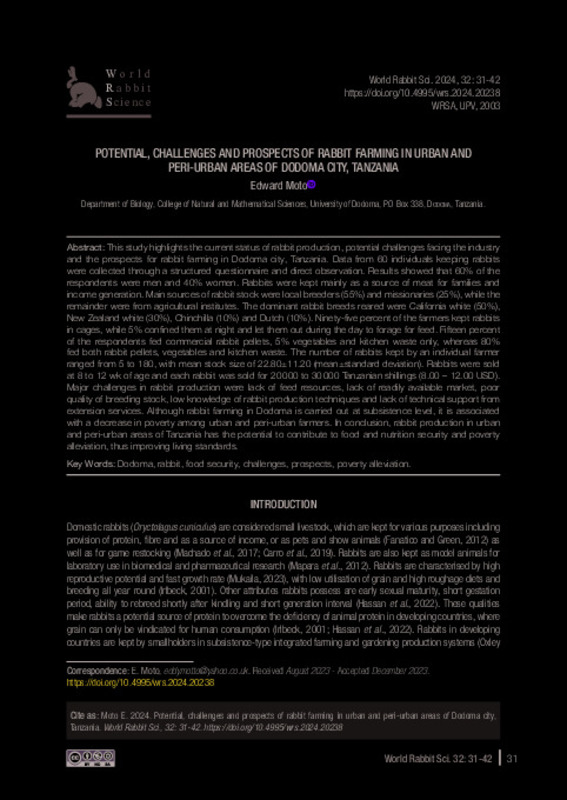JavaScript is disabled for your browser. Some features of this site may not work without it.
Buscar en RiuNet
Listar
Mi cuenta
Estadísticas
Ayuda RiuNet
Admin. UPV
Potential, challenges and prospects of rabbit farming in urban and peri-urban areas of Dodoma city, Tanzania
Mostrar el registro sencillo del ítem
Ficheros en el ítem
| dc.contributor.author | Moto, Edward
|
es_ES |
| dc.date.accessioned | 2024-04-25T07:39:05Z | |
| dc.date.available | 2024-04-25T07:39:05Z | |
| dc.date.issued | 2024-03-28 | |
| dc.identifier.issn | 1257-5011 | |
| dc.identifier.uri | http://hdl.handle.net/10251/203734 | |
| dc.description.abstract | [EN] This study highlights the current status of rabbit production, potential challenges facing the industry and the prospects for rabbit farming in Dodoma city, Tanzania. Data from 60 individuals keeping rabbits were collected through a structured questionnaire and direct observation. Results showed that 60% of the respondents were men and 40% women. Rabbits were kept mainly as a source of meat for families and income generation. Main sources of rabbit stock were local breeders (55%) and missionaries (25%), while the remainder were from agricultural institutes. The dominant rabbit breeds reared were California white (50%), New Zealand white (30%), Chinchilla (10%) and Dutch (10%). Ninety-five percent of the farmers kept rabbits in cages, while 5% confined them at night and let them out during the day to forage for feed. Fifteen percent of the respondents fed commercial rabbit pellets, 5% vegetables and kitchen waste only, whereas 80% fed both rabbit pellets, vegetables and kitchen waste. The number of rabbits kept by an individual farmer ranged from 5 to 180, with mean stock size of 22.80±11.20 (mean±standard deviation). Rabbits were sold at 8 to 12 wk of age and each rabbit was sold for 20 000 to 30 000 Tanzanian shillings (8.00 12.00 USD). Major challenges in rabbit production were lack of feed resources, lack of readily available market, poor quality of breeding stock, low knowledge of rabbit production techniques and lack of technical support from extension services. Although rabbit farming in Dodoma is carried out at subsistence level, it is associated with a decrease in poverty among urban and peri-urban farmers. In conclusion, rabbit production in urban and peri-urban areas of Tanzania has the potential to contribute to food and nutrition security and poverty alleviation, thus improving living standards. | es_ES |
| dc.language | Inglés | es_ES |
| dc.publisher | Universitat Politècnica de València | es_ES |
| dc.relation.ispartof | World Rabbit Science | es_ES |
| dc.rights | Reconocimiento - No comercial - Compartir igual (by-nc-sa) | es_ES |
| dc.subject | Dodoma | es_ES |
| dc.subject | Rabbit | es_ES |
| dc.subject | Food security | es_ES |
| dc.subject | Challenges | es_ES |
| dc.subject | Prospects | es_ES |
| dc.subject | Poverty alleviation | es_ES |
| dc.title | Potential, challenges and prospects of rabbit farming in urban and peri-urban areas of Dodoma city, Tanzania | es_ES |
| dc.type | Artículo | es_ES |
| dc.identifier.doi | 10.4995/wrs.2024.20238 | |
| dc.rights.accessRights | Abierto | es_ES |
| dc.description.bibliographicCitation | Moto, E. (2024). Potential, challenges and prospects of rabbit farming in urban and peri-urban areas of Dodoma city, Tanzania. World Rabbit Science. 32(1):31-42. https://doi.org/10.4995/wrs.2024.20238 | es_ES |
| dc.description.accrualMethod | OJS | es_ES |
| dc.relation.publisherversion | https://doi.org/10.4995/wrs.2024.20238 | es_ES |
| dc.description.upvformatpinicio | 31 | es_ES |
| dc.description.upvformatpfin | 42 | es_ES |
| dc.type.version | info:eu-repo/semantics/publishedVersion | es_ES |
| dc.description.volume | 32 | es_ES |
| dc.description.issue | 1 | es_ES |
| dc.identifier.eissn | 1989-8886 | |
| dc.relation.pasarela | OJS\20238 | es_ES |








